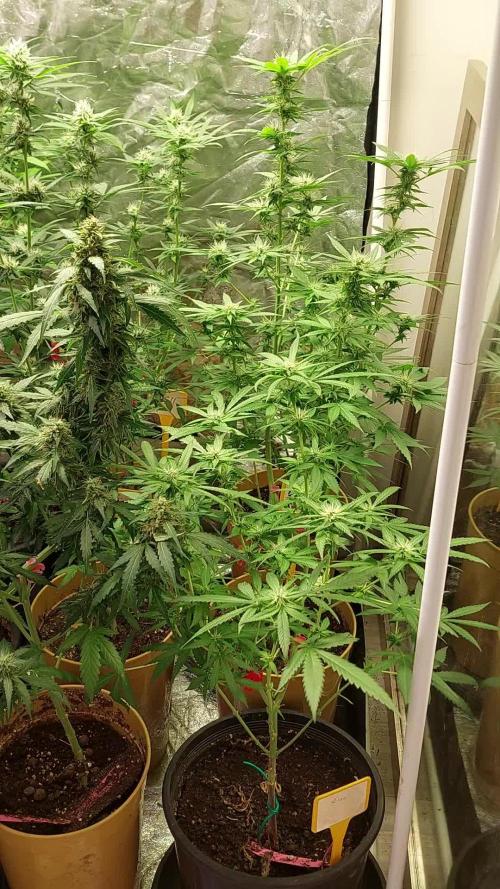The Grow Awards 2026 🏆 

























Likes
31
Share


@RFarm21
Follow
Ola growmies.
Alimentação: 17 janeiro.
Espero que tenha sido a ultima rega com nutrientes.
Ta dificil acabar este grow😅
Processing
Likes
4
Share


@Englandshigh
Follow
This week she has been thirsty,and getting really frosty and producing all her colours/pistols and dank smell,
Processing
Likes
9
Share


@Kushizlez
Follow
Everything is coming along nicely. I had some major hiccups in early flower that will probably be detrimental to my yield but at least now I know better. The two blackberry breath plants are by far the best plants in the tent. The garlics aren’t filling out like I was hoping they would and the I don’t think the cheese is going to fill out either. Getting some good terps but it’s just so airy. The slurricane looks ridiculously frosty and has some beautiful gas terps but she’s a runt, isn’t going to yield much and the powdery mildew is getting worse. I’m going to rearrange the plants in the tent to see if the pm is being caused by cold night temps or genetics. I gave one last synthetic feed to everything. I might give one more half strength depending on how done they look around day 48. I see some nice purpling and fading start.
I started a new round of seeds for my next run. I’m popping the rest of the blackberry breath’s and some other random beans I had lying around. Check out my other diary if your curious.
I just ordered a 12 pack of gelato 41 x dosido from Archive genetics for $290cad!!! I knew these elite Cali breeders were pricey but come on...
Likes
30
Share


@SubliminalSociety
Follow
Yo growmies!
While all of Berlin was getting high at Mary Jane 2024, I paid my ladies a visit:
Remember last week's manic defoliation? Yeah, let's just say I went a little Edward Scissorhands on the Pineapple Poison. It's because last year's monstrous Gelato that took two days to harvest (my arms were killing me!). This year's mission: big, juicy colas and a speedy harvest (last year it took us 2 days!).
Well, the good news is, the Pineapple Poison is a tough cookie (or should I say, pineapple?). She bounced back like a champ! She's still on the short and bushy side, so I'm giving her a break from the shears this week. Just a few tiny shoots close to the main stem got evicted to keep those main colas in the spotlight.
Speaking of spotlights, I also made a trippy video to test visuals for the contest. Let me know what you think of the hazy, dream-like vibe. Is it artsy or just accidentally blurry? You be the judge!
Oh, and I discovered a couple of resident snails on the Pineapple Poison. Thankfully, these little guys seem to be no harm. We'll call them our "ganja garden guardians". In fact, I noticed with every outdoor grow that Cannabis plants create a tiny ecosystem for all kinds creepers and crawlers who like to soak up the flower fumes and chill out in the leafy shade,
Stay tuned, growmies!
Next week, we'll see if the Pineapple Poison keeps on churning out those juicy colas.
And who knows, maybe I'll find a way to channel my inner pruning master without turning this into a harvest marathon again!
High fives all around!
Likes
12
Share


@Z420Organics
Follow
The plants are doing great overall! 💪🌿
RS11 is filling up beautifully — the structure looks amazing and the sweet smell is starting to show! 🍬✨
Amnesi-K Lemon has such juicy-looking buds 🍋💦 — that’s honestly the best way I can describe them right now.
The surprise of the run is definitely Apple and Bananas 🍎🍌 — the plants are packing on heavy trichomes, even on the sugar leaves. This one’s going to be an interesting strain for sure! ❄️🔥
Monkey Grease is growing steady and strong — zero issues so far 🙌🌱.
Cherry Dreams… well, that’s where I made a big mistake 😅. When I mixed the soil, my ppm meter turned out to be faulty — so they went into a very hot mix. I’m currently flushing to remove excess salts so the roots can breathe and work properly again 💧🌿. Lost some time there, and they’re definitely behind compared to the others. But hey, it’s all part of the learning process. This will be an interesting one to see how it finishes! 🧠✨.
Likes
29
Share


@Ultraviolet
Follow
Hope you are well. Thanks for taking the time.
Little main line defoliation to focus growth.
ATP (adenosine triphosphate) is the primary energy carrier in cells, including plant cells. It powers various cellular activities like nutrient uptake, protein synthesis, and cell division. Without ATP, the plant's metabolic machinery would grind to a halt, regardless of the presence of nutrients, oxygen, or carbon. Nutrients, like nitrogen, phosphorus, and potassium, are essential for building plant tissues and various molecules. They are incorporated into proteins, nucleic acids, and other vital compounds. While crucial, their uptake and utilization rely on ATP-driven processes. Oxygen is vital for cellular respiration, a process that generates ATP. While plants can produce ATP through photosynthesis, oxygen is essential for maximizing ATP production in mitochondria through oxidative phosphorylation. Carbon is the backbone of all organic molecules, including carbohydrates synthesized during photosynthesis. It's the fundamental building block of plant structures and fuels. However, its incorporation into organic molecules is also ATP-dependent.
We don't grow we facilitate energy conversion.
Processing
Likes
10
Share


@CreoWeed
Follow
Hey guys, this other week went very cool, I start reducing the nuts to the minimum and I can see really how fattening are the buds.
Now I can see some pretty milky trichomes, and just few cloudy, so I consider to chop in max 2 full weeks... (71 total days from seed) but anyway I'll adapt to how the plant is at that time.
The smell it's absolutely, insanely strong and ill need to buy ASAP a carbon filter to reduce it.
The only issue encountered in this grow was keeping low the humidity, and in fact I was not really able to do so as it stands at 55-65...but without noticing any mold issue on flowers.
Can wait to update this post next week!
Stay tuned, stay high!
Likes
39
Share


@BlackDragon22
Follow
È veramente un mostro a parere mio. Cresce a vista d'occhio ogni giorno, ho dovuto rivedere il baldacchino, non smette di crescere.. Quindi ho eseguito ancora Lst. Tra qualche settimana sarà solo lei nella tenda.. Non vedo l'ora perché si è presa già tutto lo spazio
Likes
11
Share


@Microsun
Follow
Flowering is going amazing, this candy cane is growing some very fast weight and caking up with Trichome’s. The sweet and slightly minty berry smell is growing in power day by day, and I’m very happy with how the size of the buds are developing since adding the increase of 2-8-4 and fish bone meal, just a little bit, not too much at all and she’s reacting great, knowing that the candy cane is a larger auto in size makes me a bit sad with the total size of this plant, but in its young age as my very first auto I believe I probably stunted it, but after all this and how she looks now Im more than happy with the growth, yield and quality of it, just speaking now as I do not obviously know how much I Will revive from it, I’m guessing about a ounce. No small bud sites other than maybe one on a lower branch that already has a main top cola on it. The main cola is massive and packing on a lot of size. I’ve switched the light to a hour less now as I am growing 2 photo indica L.A grape and with the season change I am having to fix my temp and humidity more for the photos, so changing to a 17-7 schedule has actually helped quite a lot and also has helped my other autos veg slightly better. But all in all I’m very exited!
Likes
14
Share


@MrReeferMadness
Follow
The psychosis looks like it's stopped growing right at it limit for the space that it is in... hopefully it doesn't grow anymore than 4 inches from now.
All plants are doing great tbh and the space is getting limited for maintenance now but after week five I won't need be inside the room until around harvest time !!
Likes
3
Share


@Muxa752
Follow
Цветение скучная пора, ну оно и к лучшему , походу дела гров получится. без серьезных ошибок) шишки набираю вес . пытался рассмотреть трихомы , получилось не очень , вроде уже мутные . но спешить не будем . удобы убрал вообще , побольше промою водичкой . напомню , все делается без измерений PH. на видео показан состояние грунта , корневая развита , аэрации помогают мелкие существа )
Likes
36
Share


@ganjameister
Follow
This week I have been steering vegetatively. Less stress on the plants to increase the weight on the buds.
Watering is done very often and the plants are drinking a lot. EC lowered to 3.0 and the VPD has been reduced which means higher humidity than usual.
The buds are getting bigger and I’m seeing a slight shade of dark purple on the bud!
Processing
Likes
38
Share


@Wicked_Stix
Follow
Gave the girls a flush and a complete water change this week. That was only the second water change they have had this grow. I have just been letting them drink the reservoir almost empty and then filling it up with fresh nutes. The 5 plants are drinking about 4 gallons a day combined. Been running AC when the lights are on and the dehumidifier 24 hours a day. All of the plants are showing some decent trichome production. Running 1/2 tsp maxibloom and 1/8 tsp beastie bloomz per gallon every time I add water. Seems to be keeping everyone happy.































